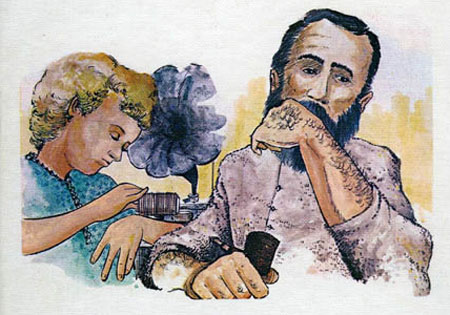
The
Christmas of the Phonograph Records
by Mari Sandoz
Illustrated by James W. Brown, University of Nebraska Press -
Lincoln Copyright © 1966 by the Estate of Mari Sandoz
By Doug Boilesen
The Christmas of the Phonograph
Records - A Recollection is one of my favorite books and as
much a part of our family Holiday Season as A Visit from St.
Nicholas by Clement Clarke Moore and A
Christmas Carol by Charles Dickens.
Mari grew up on a western Nebraska
government claim where life at the beginning of the twentieth
century could be harsh and isolated, particularly in the winter.
In this story Mari's father Jules purchases a Phonograph with
inheritance money and neighbors come from miles away during the
Christmas holiday to listen to the wonderous machine. Mari's mother
is distressed over the extravagance of the purchase since the
children need overshoes and there is a mortgage to be paid. But
Mari observed that her mother's eyes shined when she listened
to the music of the phonograph with "excitement I had never
seen in them."
The following is the
opening page from Mari Sandoz's recollection The Christmas of
the Phonograph Records:
It seems to
me that I remember it all quite clearly. The night was very
cold, footsteps squeaking in the frozen snow that had lain
on for over two weeks, the roads in our region practically
unbroken. But now the holidays were coming and wagons had
pushed out on the long miles to the railroad, with men enough
to scoop a trail for each other through the deeper drifts.
My small brother
and I had been asleep in our attic bed long enough to frost
the cover of the feather tick at our faces when there was
a shouting in the road before the house, running steps, and
then the sound of the broom handle thumping against the ceiling
below us, and father booming out, "Get up! The phonograph
is here!" (p.3)
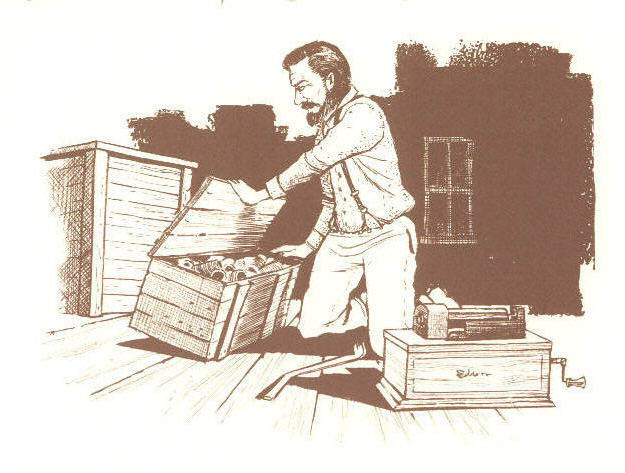
Illustration
by James W. Brown (Courtesy
of the Estate of Mari Sandoz)
The phonograph was varnished oak,
with a shining cylinder for playing the records, and a horn, "a
great black, gilt-ribbed morning glory, and the crazy angled rod
arm and chain to hold it in place." After
the machine was unpacked and set up in the kitchen-living room
a brown wax cylinder was removed from its round paper container
and slipped onto the cylinder. The machine's handle was carefully
cranked, and the needle set down.
"Everybody waited, leaning
forward. There was a rhythmic frying in the silence, and then
a whispering of sound, soft and very, very far away.
It brought a murmur of disappointment
and an escaping laugh, but gradually the whispers loudened into
the sextet from Lucia, into what still seems to me the most
beautiful singing in the world." (p.
5)
Other records then followed with
many titles remembered and
named by Mari years later when she wrote her story.
What did Mari's younger brothers
think about that Christmas and the phonograph? "None
of them missed the presents that we never expected on Christmas;
besides, what could be finer than the phonograph?"
(p.13)
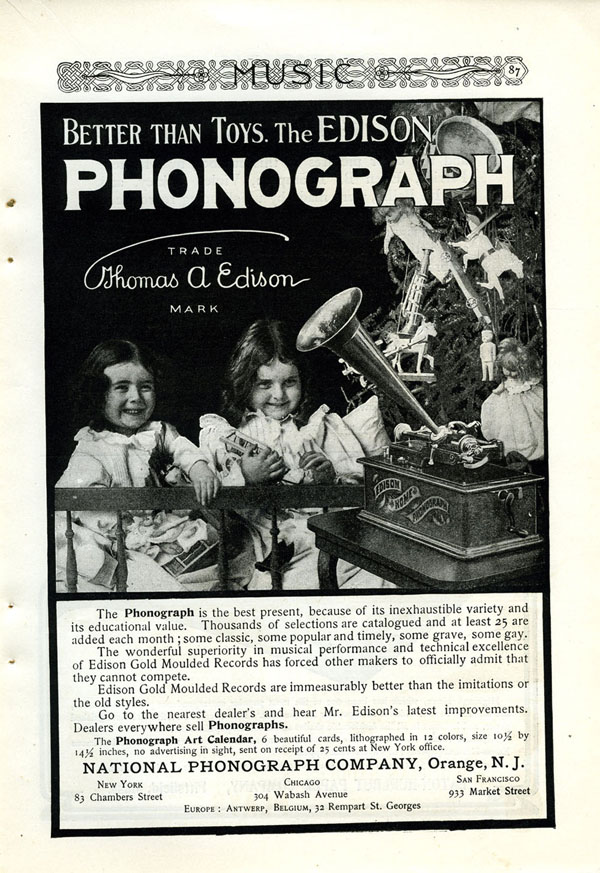
Better Than Toys. The Edison
Phonograph. December 1903 (PM-0882)
"The Phonograph
is the best present" stated the December 1903 Edison magazine
ad. Although this Christmas scene couldn't be further away from
Mari's own reality, the happy home made possible by the phonograph
was a common theme in phonograph advertising along with its explanation
that the phonograph is "the best present, because of its
inexhaustible variety and its educational value."
For the Christmas holiday
week of 1908 outside Hay Springs, Nebraska at the house
of Jules and Mary Sandoz the new phonograph did bring
together family, friends and neighbors. Even one of Jules'
enemies was allowed under his roof (which was no
minor event as Jules was known for his violent temper
and for being "a crack shot"). Likewise remarkable
was the variety of recordings everyone heard.
Mari would also see something
that week in her mother's face that she hadn't realized
before:
"We
all clustered around, the visitors, fourteen, fifteen
by now, and mother too, caught while pouring hot chocolate
into cups, her long-handled pan still tilted in the air.
Looking back I realize something of the meaning of the
light in her face: the hunger for music she must have
felt, coming from Switzerland, the country of music, to
a western Nebraska government claim. True, we sang old
country songs in the evenings, she leading, teaching us
all she knew, but plainly it had not been enough, really
nothing." (pp. 5-6)
The story closes some
time later on a warmish day with Mari going out to
the well to fill the water pail but leaving the door
to the house open. Their big old sow pushed her way
into the house, knocked down the record cabinet, scattered
the cylinders over the floor and chomped down the
wax records, boxes and all.
For Friends of the Phonograph
it's a sad ending for the cylinder records. But sadder still
was the last line of the story and the reality of Old Jules's
"physical and emotional abuse"(1)
of his family as Mari received what she said was "the
worst whipping in my life for my carelessness, but the loss of
the records hurt more, and much, much longer." (p. 27)

Illustration
by James W. Brown (Courtesy
of the Estate of Mari Sandoz)
See Phonographia's Referenced
Records for a listing of the cylinder records identified in
The Christmas of the Phonograph by Mari Sandoz.
Speculation about when this story
took place
Christmas Eve, 1908 - New
Year's Day, 1909
Establishing the year of this
Holiday story and the model of the Edison phonograph purchased
by Mari's father Jules Sandoz, a.k.a. "Old Jules,"
requires some speculation while also remembering that this
was a "recollection" written decades later.
I think this story took place
from December 24, 1908 to New Year's Day, 1909. There are
some inconsistencies in selecting 1908 as the year. For instance,
Mari's reference to her "German-accented fifth-grade
country school English" when she is reading the instructions
for the phonograph and the fact that Mari doesn't mention
her sister Caroline, who was born on May 12, 1906 and who
would have been one and a half years old if it was Christmas
1908. See Endnote
(1) for more details regarding 1908 as being a somewhat
less than definitive year for when the Christmas of the
Phonograph Records took place.
But does the exact year even
matter?
No, not from a story perspective.
This gallery, however, is part of Phonographia.com which is
all about phonograph connections so the year is important
to determine which phonograph Old Jules might have bought.
The year also adds context in
the timeline of consumerism and the phonograph's social and
cultural revolution but for popular culture it doesn't need
to be an exact date. In the small communities in the Sand
Hills of Nebraska people could have read about the phonograph
in the late 1880's and 1890's and that curiosity and interest
would also continue into the new century.
Local newspapers like the Hay
Springs Leader, and Rushville Standard, and the
Gordon Journal in the early 1900's reported on the
phonograph's growing presence in communities as a public entertainer.
Later articles wrote how the phonograph was moving into homes
with recent local purchases of a phonograph even being identified
in newspapers as part of its promotion.

“phonograph entertainments,”
Rushville Standard, February 14, 1901
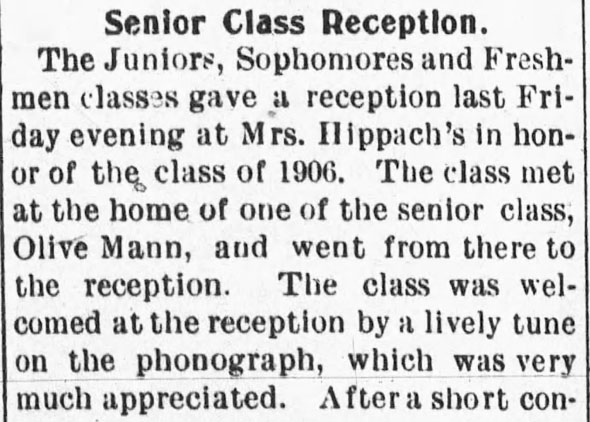
“Senior Class
Reception welcomed by the phonograph,” The Rushville Recorder,
May 18, 1906

J. H. Dixon Johnson
purchased a Phonograph. The Gordon Journal, April 5,
1907
Stories and jokes about the
phonograph were also repeated in newspapers with most originating
in national publications. Phonograph advertisements by regional
stores appeared when places like Gordon's Jeweler & Optician
and the Hardware Store started selling phonographs and records.
The phonograph at the beginning of the 20th century was becoming
part of popular culture and daily life.

The
Gordon Journal, August 29, 1902
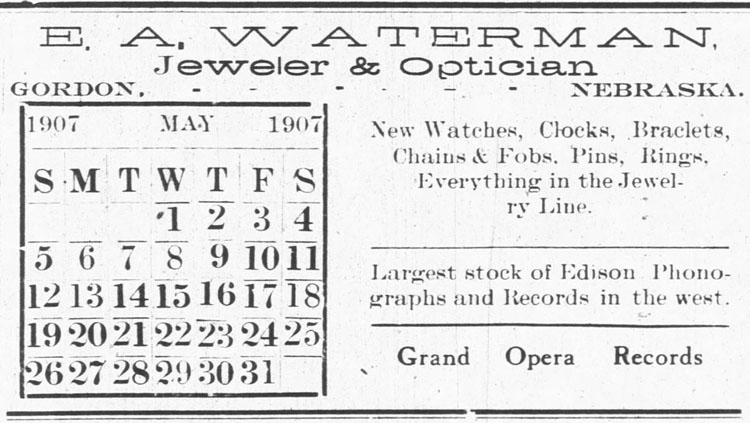
The
Gordon Journal, May 31, 1907
Waterman's
Jeweler & Optician, and Jordan's both of Gordon,
Nebraska were the closest stores to the Sandoz homestead
where Edison Phonographs and Records could be purchased.
"Edison’s
Famous Phonographs” at Jordan Hardware Co’s.,
The Rushville Recorder, February 7, 1908
The Gordon Journal, January
17, January 24, February 28, March 6, March 13 and March 20, 1908
- Edison Phonograph ad for
Chapman’s in Valentine, Nebraska said it had the "largest
stock of Edison Records in N. W. Nebraska"
Not everyone subscribed or even
read a newspaper and "many rural dwellers picked up their
mail only once a week and even as late as 1896, only letters,
no packages were handled." What the Sandoz family read
in 1908 is unknown but virtually all of Nebraska was connected
by 1904 in the post office's newly formed Rural Free Delivery
(RFD) so even a remote homestead in the Nebraska Sand Hills
could receive mail. Parcels and shipments like the phonograph
and its records were handled by firms such as Wells Fargo,
which formed in 1866, and became American Railway Express
in 1918." (2)
Since all of the records and
the phonograph arrived by rail and were delivered at the same
time it's likely that Jules purchased everything as a mail
order.
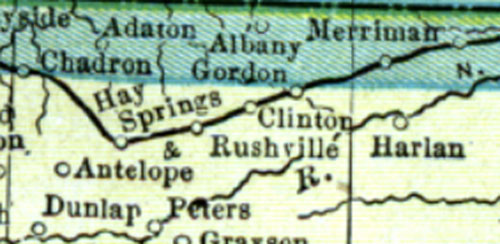
1909 map showing
train stations at Hay Springs, Rushville and Gordon on the
Chicago & North Western's Railroad Line (Courtesy Adam
Burns) (3)
On the morning when the phonograph
was delivered it had been possible for that delivery because
"wagons had pushed out on the long miles to the railroad,
with men enough to scoop a trail for each other through the
deeper drifts." (p. 3)
"Lamplight was pouring
from the open door in a cloud of freezing mist over the
back end of a loaded wagon, with three neighbors easing
great boxes off, father limping back and forth shouting,
"Don't break me my reads!" his breath white around
his dark beard." (p. 4)

Illustration
by James W. Brown (Courtesy
of the Estate of Mari Sandoz)
The Cylinder Records
Mari remembers how the "brown
wax" cylinders (p. 5) were slipped onto the machine
and that her place was established from the start. "I
was to run the machine, play the two-minute records set
before me." (p. 6)
New releases of two-minute cylinder
records would continue to be promoted each month by Edison
until 1912, however, Edison's four-minute black wax "Amberol,"
introduced in October 1908 would later continue as a celluloid
four-minute record until 1929. Playing twice as long as the
Edison Gold Moulded Record, the Amberol Record was said "to
play better, their tone quality richer, clearer and more delicate
than has been possible in the past." (The Edison Phonograph
Monthly, October 1908)
What Phonograph was purchased
by Old Jules?
"At a school program"
people had heard "about the Edison phonograph going
out to Old Jules Sandoz" so we know the phonograph
purchased was an Edison. (p.5)
Edison Phonograph models
before Christmas 1908 could have been a 2-minute machine
or one of Edison's new 2 and 4-minute combination machines
introduced in October 1908. (4)
Mari's description of their
phonograph was that is was "varnished oak, with a
shining cylinder for the records, and then the horn, a great
black, gilt-ribbed morning glory, and the crazy angled rod
arm and chain to hold it in place."
One of the following is most
likely the Edison Phonograph purchased by Jules Sandoz.
The Edison
Standard Phonograph Model C, introduced in February 1908
as a 2-minute machine with a suspended straight polygonal
horn with 10 panels, 30 inch length, 19 inch diameter of bell;
black with gilt decoration.
The Edison Standard Phonograph
Model D, introduced in October 1908 as a 2 and 4-minute
combination machine and 10-panel black horn (known as a
Morning Glory Horn).
Edison STANDARD Phonograph
Model D, with Morning Glory Horn. (courtesy The Edison Cylinder
Phonographs 1877-1929, Frow & Sefl, ©1978 by George
L. Frow)
The Edison Home Phonograph
Model C introduced after mid-February 1908 as the regular
2-minute machine with 11-panelled horn.
Edison HOME Phonograph Model
C. A catalogue picture showing the straight 11-panelled horn
(courtesy The Edison Cylinder Phonographs 1877-1929,
Frow & Sefl, ©1978 by George L. Frow)
The Edison Home Phonograph
Model D introduced in October 1908, standard finish was
oak, 2 and 4-minute combination, with straight 11-paneled
horn.
The Edison Triumph Phonograph
Model C introduced in February 1908 as regular 2-minute
machine, with 33 inch 12-panelled straight horn.
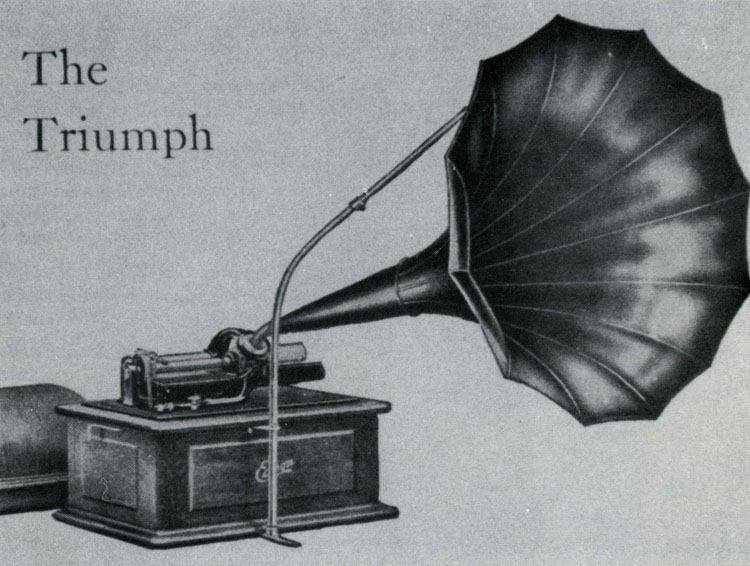
Edison TRIUMPH Phonograph
Model C with straight 12-panelled horn (courtesy The Edison
Cylinder Phonographs 1877-1929, Frow & Sefl, ©1978
by George L. Frow)
The Edison Triumph Phonograph
Model D introduced October 1908, oak, combination 2 and
4-minute, with 33 inch 12-panelled straight horn.
Edison
and other phonograph companies advertised by mail, in magazines
and in newspapers but consistently they asked the public to
visit a dealer and listen for themselves. We don't know when
Old Jules heard his first phonograph or how he made his decision
on the model of the Edison phonograph and the records. And
we don't know who made the sale. There would have been opportunities
for the public to have heard a phonograph at a social gathering
in town or to go to one of the retail stores (e.g., Jordan
Hardware or E. A. Waterman's) where Edison phonographs were
sold, and a few people in Gordon and Rushville and Hay Springs
owned a phonograph. But Old Jules's purchase was still a significant
event for the area even if any of his visitors had previously
heard a phonograph. The rarity of some of the records that
Jules had purchased gave his "guests" the opportunity
to hear records never before heard in the area.
"People appeared
from fifty, sixty miles away and farther so long as
the new snow held off, for there was no other such
collection of records in all of western Nebraska,
and none with such an open door."
If Old Jules did
purchase his Edison for the Christmas Holiday in 1908
it's another example of the how popular the Edison cylinder
machines still were in areas like the Nebraska's Sand
Hills. The battle between cylinders and discs as record
formats was changing course with more companies making
disc machines and records.
Sears, Roebuck and Co.,
started selling Columbia graphophones (American Graphophone
Co.) cylinder playing machines in the late 1890's and
were still selling them in 1908. But in the spring of
1902 "while the cylinders were still in their hey-day,
the interloping disc machines had finally arrived in
the new Sears catalog. Nor is the fact to be taken lightly,
for not before the disc had begun to sell well would
Sears have considered taking on sales of disc products."
(5)
In 1906 Pathé Frères,
one of the largest manufacturers, quit "the cylinder
business altogether and concentrated on disc records."
(6). Victor
introduced their Victor-Victrola in 1906 and Columbia
in 1907 introduced their own internal horn phonograph
called the Grafonola. Of the big three phonograph companies
Edison would now be the only one fully committed to
cylinder records and their machines. Disc
machines, therefore, were becoming the dominant format
but in 1908 Edison's cylinder phonograph was still selling
many machines and with its 4-minute Blue Amberol records
introduced in 1912 Edison would continue to sell records
into the 1920's.
The growth of the disc
machine led by the Victor Talking Machine and the Columbia
Phonograph Company in the first decade of the twentieth
century also became a competition by those two companies
to have their recording artists be "The Greatest
Artists in the World." The Victor Company signed
Enrico Caruso in 1904 and other opera stars were joining
the new recording industry. Opera and its celebrity
opera stars would become major advertising subjects
for Victor to promote its supremacy in recorded music.
Style also became
a selling point with the introduction of the Victrola
and its stately cabinet with its internal horn creating
an attractive incentive to remove a phonograph horn
from the parlor.
Perhaps Old Jules had
never seen
or heard a Victor disc record. But even if he had
the popular culture associated with the Edison was a
much closer fit for a Nebraska homestead than the Metropolitan
Opera stage promoted by Victor.
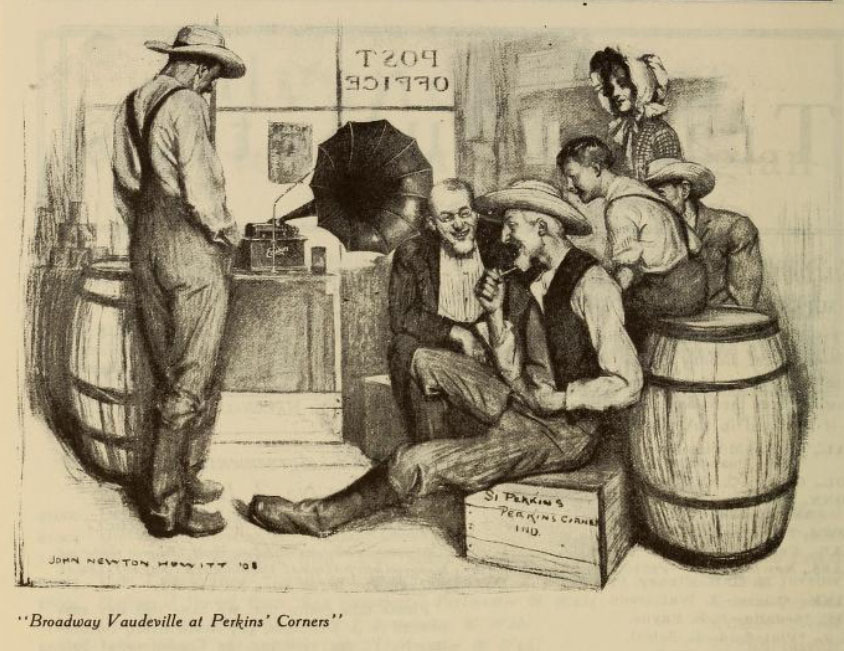
The Edison
Phonograph Monthly showing their illustration for their
August 1908 advertisements
We know that Jules bought foreign
records from a Swiss friend in New York so that friend may
have also influenced Jules in selecting a phonograph.
No matter which of the Edison's
was purchased one can still visualize it as an Edison Phonograph
with "its great black, gilt-ribbed morning glory"
horn sitting inside the "weathered little frame house."
One can also be confident that from Christmas Eve 1908 to
New Year's Day 1909 the Sandoz Edison Phonograph was performing
to its largest and most appreciative audience that would ever
listen to it.
I think Old Jules purchased
the oak Edison
Home Phonograph Model D introduced in October 1908,
2 and 4-minute combination, with its 11-paneled horn
(a choice perhaps overly influenced by my hope that
Mari listened to Edison's Amberol 4-minute version of
sextet of "Lucia" as her first record).
In the following years It would
be played again using the records that would be stored in
flat boxes under the bed while the "finest from both
the Edison and the foreign recordings, were put into this
cabinet, with a door that didn't stay closed."
But their house was small, the
children were growing, and the horn was probably too big for
the phonograph to remain assembled on the washstand in the
bedroom.
If the phonograph didn't get
played as much after that memorable holiday week maybe there
was still an upside. The one thing Mari said she wanted to
do but had forgotten to do because of the dancing and the
music of the Phonograph, was for her and Jule to sing their
new song, Amerika ist ein schönes Land at the
tree.
Perhaps for the Christmas of
1909 more singing took place.
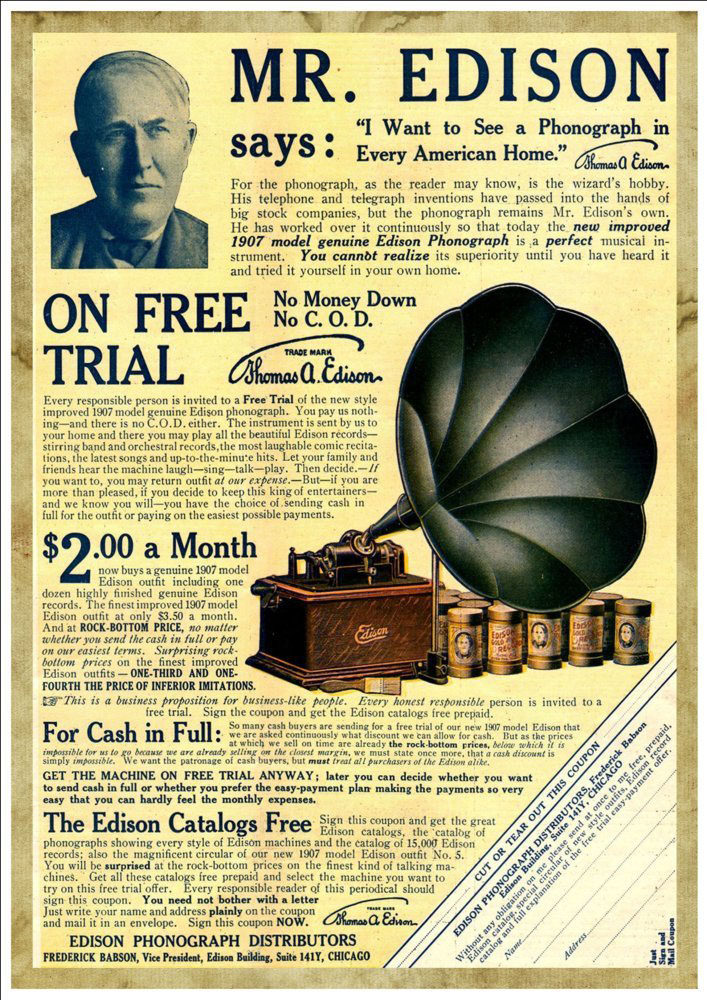
1907 Phonograph Ad from one of Edison's
National Distributors
The Cylinder Records
Referenced in the Story
Besides the record titles specifically
named in the story there are other general references which describe
some of the "extravagant" collection Old Jules had purchased.
There were "a couple of
the expensive French records of pieces he had learned to play
indifferently in the violin lessons of his boyhood in Neuchatel."
(p. 13)
"He didn't say how many,
nor that there were other brands besides the Edison here, including
several hundred foreign recordings obtained through a Swiss friend
in New York, at a stiff price." (p.8)
"Waltzes, two-steps, quadrilles,
and schottisches were sorted out and set in a row ready for me
to play..." (pp. 9-10)
There were "several German
love songs he had learned from his sweetheart, in Zurich, who
had not followed him to America." (p. 13)
"Soothing music" was selected:
"Bach, Mozaart, Brahms, and the Moonlight Sonota on two
foreign records that father had hidden away so that they would
not be broken..." (p. 17)
"...and a little Strauss
and Puccini, while the young people wanted Ada Jones and "Monkey
Land" by Collins and Harlan." (p. 17)
"There was something for
everybody, Irishmen, Scots, Swedes, Danes, Poles, Czechs as well
as the Germans and the rest, something pleasant and nostalgic."
(p. 22)
For record titles identified in
Mari's story see Phonographia's Factola Referenced
Records in The Christmas of the Phonograph Records.
Other Related Images and Annotations
to The Christmas of the Phonograph Records.

Rushville Register,
September 18, 1908
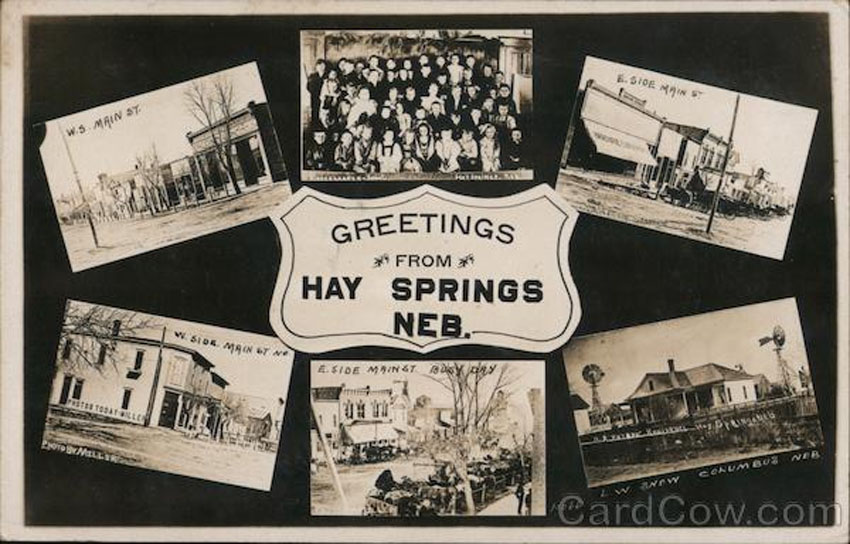
Hay Springs postcard,
July 18, 1910
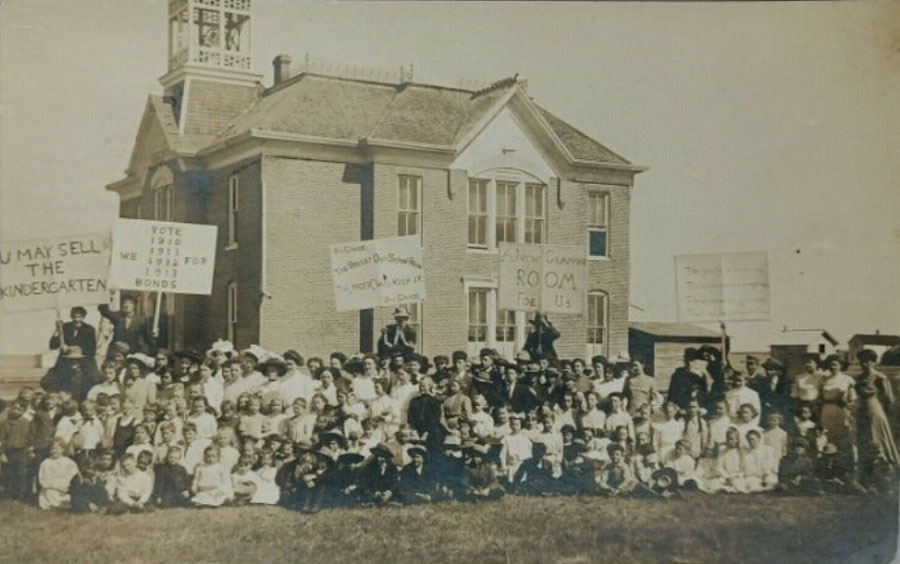
Hay Springs School,
May 28, 1910
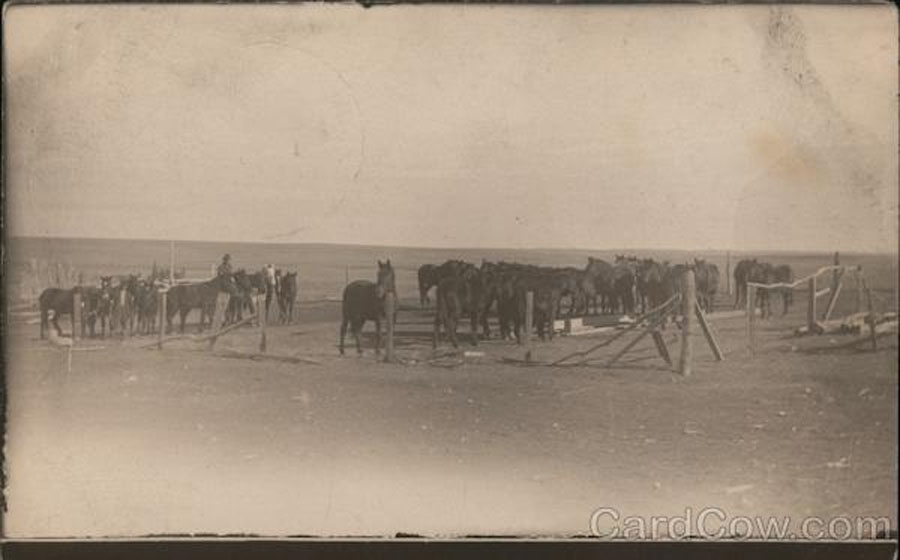
Rushville, NE postcard,
January 1911
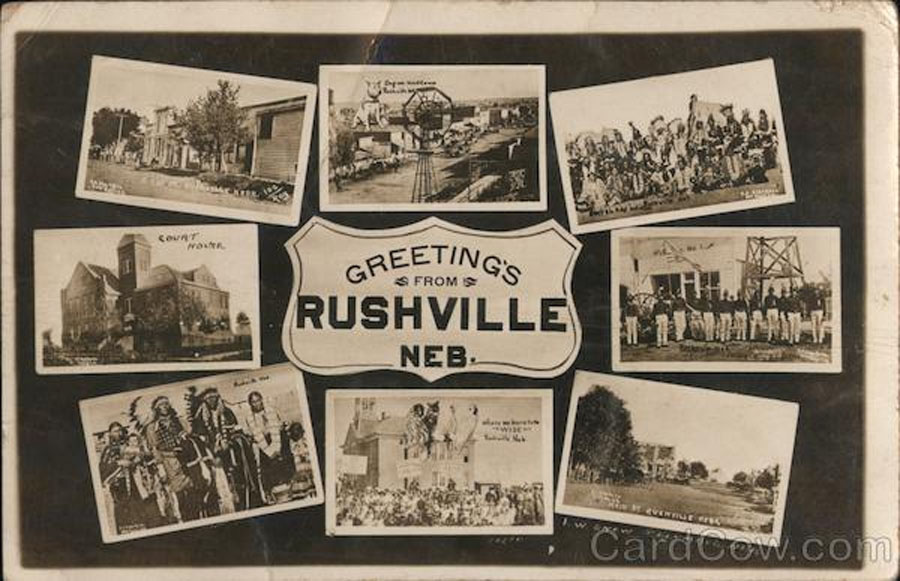
Rushville, NE postcard,
September 5, 1911

Washstand, circa
1900
"By now the
phonograph had been moved to the top of the washstand in our parents'
kalsomined bedroom, people sitting on the two double beds, on
the round-topped trunk...The little round boxes stood everywhere,
on the dresser and on the board laid from there to the washstand
and on the window sills..."(p. 7)
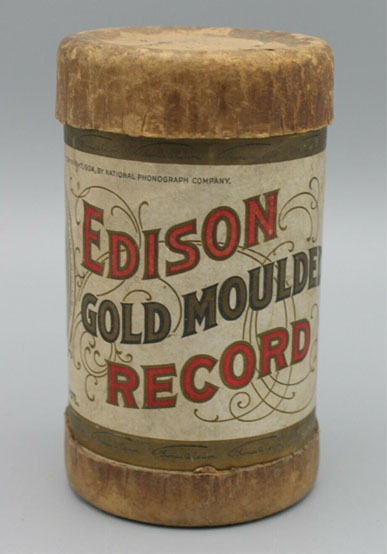 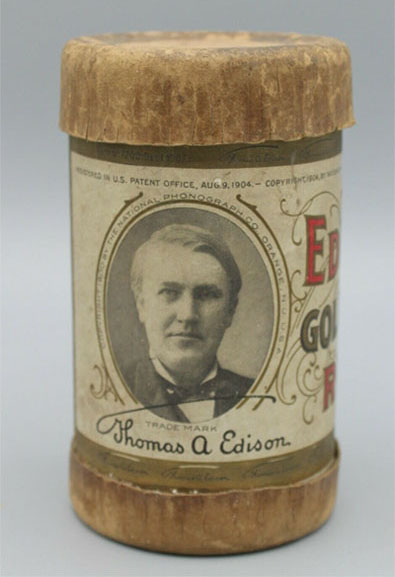
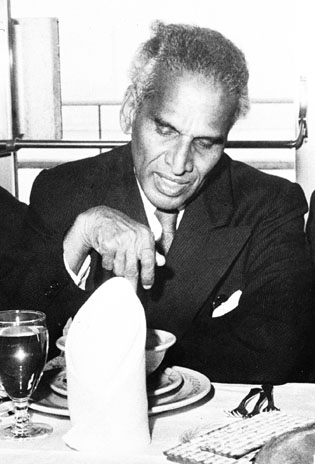
Krishna Menon, 1958
"Early in the
forenoon the Syrian peddler we called Soloman drew up in the yard
with his high four-horse wagon. I remember him every time I see
a picture of Krishna Menon---the tufted hair, the same lean yellowish
face and long white teeth. Solomon liked to strike our place for
Christmas because there might be customers around and besides
there was no display of religion to make him uncomfortable in
his Mohammedanism, father said, although one might run into a
stamp-collecting priest or a hungry preacher at our house almost
any other time. "
So far as I know,
Solomon was the first to express what others must have thought.
"Excuse it please, Mrs. Sandoz," he said, in the polite
way of peddlers, "but it seem to uneducated man like me the
new music is for fine palace---"
Father heard him.
"Nothing's too good for my family and my neighbors,"
he roared out.
"The children
have the frozen feet---" the man said quietly.
"Frozen feet
heal! What you put in the mind lasts!" (pp.
14-15).
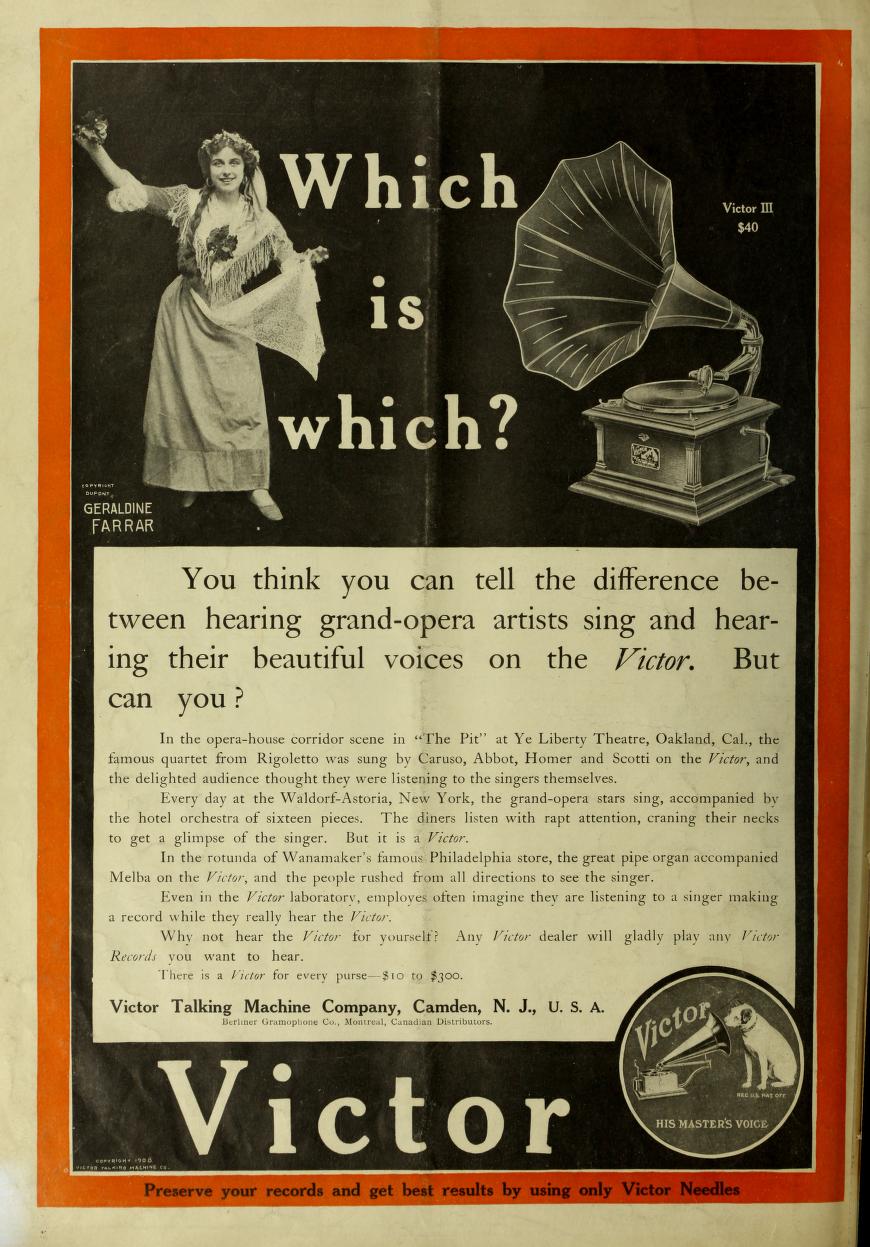
The Victor III and
Geraldine Farrar, Colliers, 1908
FACTOLA: In Mari Sandoz's
"recollection" short story The
Christmas of the Phonograph Records
her father's extravagant and much anticipated
Phonograph is delivered to their isolated homestead in western
Nebraska just in time for Christmas. The first cylinder record
they play is the sextet from "Lucia di Lammermoor" by Donizetti.
Mari remembers that moment of hearing Lucia as "what
still seems to me the most beautiful singing in the world."
For more examples of the phonograph
in popular culture and daily life as seen in newspapers of Sheridan
County, Nebraska 1890-1910 see Phonographia's Newspapers
and the Phonograph in Sheridan County.

Phonographia
|

